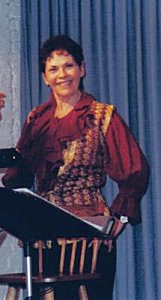Anne Fielding |
| I Believe
This About Acting By Anne Fielding * In An Actor Prepares, Constantin Stanislavski writes: A real artist must lead a full, interesting, varied, and exciting life. . . . He should study the life . . . of the people who surround him. We need a broad point of view to act.My first acting training at the School of Performing Arts was based on the Stanislavski method—a method I have enormous respect for. He says: "We need a broad point of view to act." That is exactly what Aesthetic Realism provides. It is broad and exact at once. Eli Siegel knows the nature of self more truly than anyone in history, and he describes what selves and actors are looking for. "People are trying to put opposites together," says Siegel. Actors are also trying to put opposites together. Aesthetic Realism says further that the purpose of acting is to care for the world honestly, not to escape from it. This is true about acting of every period and style, and it is new in theatrical education. I have learned that acting shows a person's desire to become other people as a means of becoming more oneself. Anything else is untrue to acting and untrue to the self. I believe that the opposites as described by Eli Siegel are present and crucial from the moment we have a script in our hands, a character in our minds, through all the rehearsals, up until the final performance. Even the remembrance of a performance has the opposites in it. There are Spontaneity and Plan at every moment. An actor has to be willing to be surprised, even as he has a scene or an entire play carefully thought out. We have to know our lines and movements and cues and inner desires, let alone what we are doing and where we are; and at the same time we must welcome and even look for the unexpected. Great actors have spontaneity and plan working
simultaneously. For example,
in a scene from the film On the Waterfront, Marlon Brando did
something
wonderfully unexpected with a glove. He is walking along with Eva Marie
Saint, interested in her, shy, but trying to appear self-assured.
Accidentally,
the actress dropped her glove. Brando picked it up, went on talking,
and,
as if he was unaware of what he was doing, put her small glove on his
ever
so much larger hand. Another actor might have ignored the glove, or
perhaps
picked it up and given it back to her, or even stopped the scene and
insisted
on doing it over. But Brando welcomed the unexpected, and that scene is
famous—talked of in acting classes everywhere as an example of
spontaneous
creative imagination. You cannot tell whether it is planned or
unplanned.
It is both. And it is art.
Reprinted with the permission
of Definition
Press from Aesthetic Realism: We Have Been There, Six Artists on
the
Siegel Theory of Opposites: Definition Press, New York, 1969. BIO, 1969: Anne Fielding has studied acting with Michael Howard and musical comedy with Charles Nelson Reilly. An Obie Award winner, she has been seen on and off-Broadway and on television both here and in Canada. Miss Fielding appeared as Juliet in Romeo and Juliet and as Hermia in A Midsummer Night's Dream for the New York Shakespeare Festival, and was a member of the American Shakespeare Festival for two years. She is part of the original cast of Hamlet: Revisited. On the faculty of the HB Studio as a teacher of musical comedy, she has been seen most recently as The Girl in The Fantasticks. |

